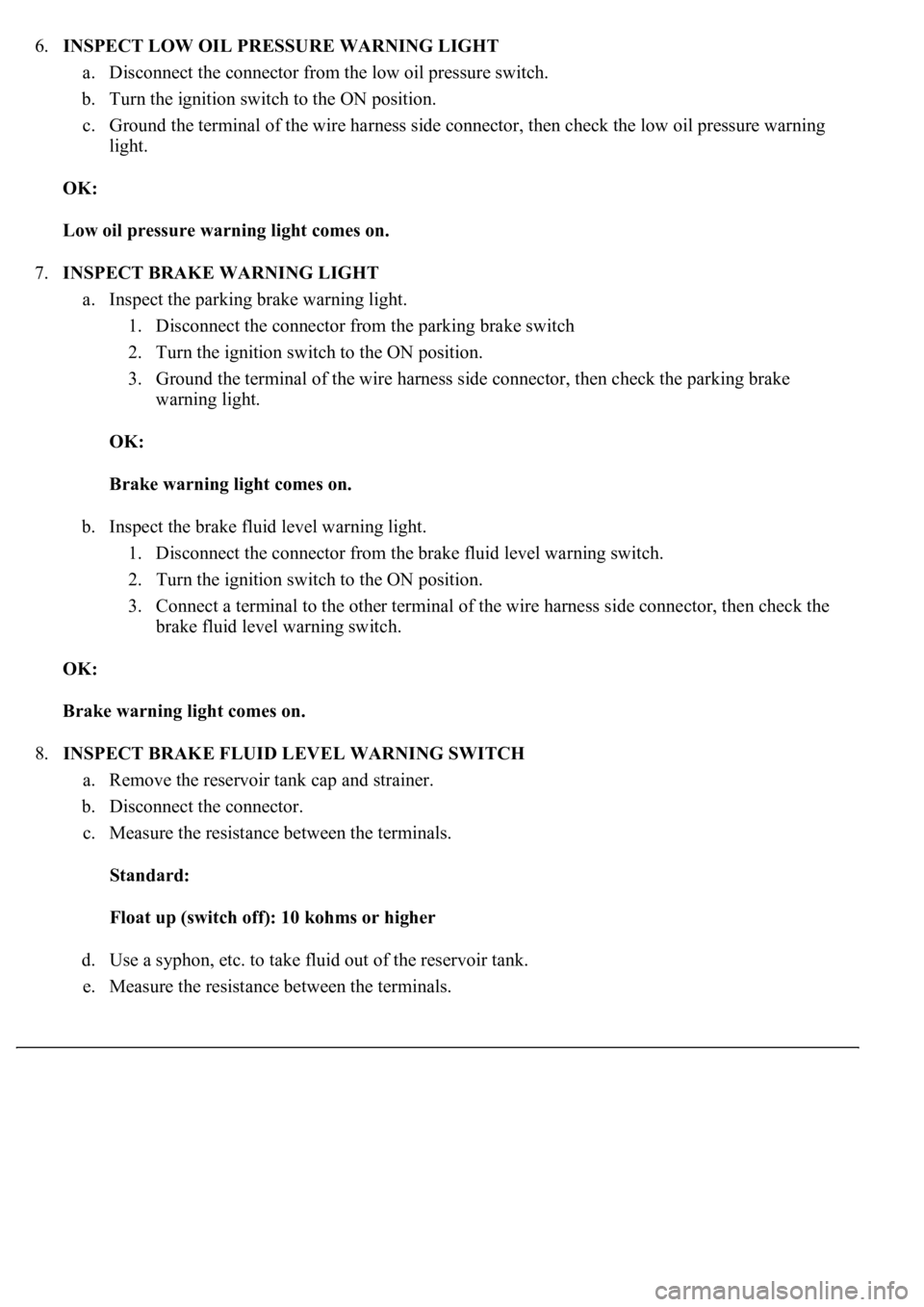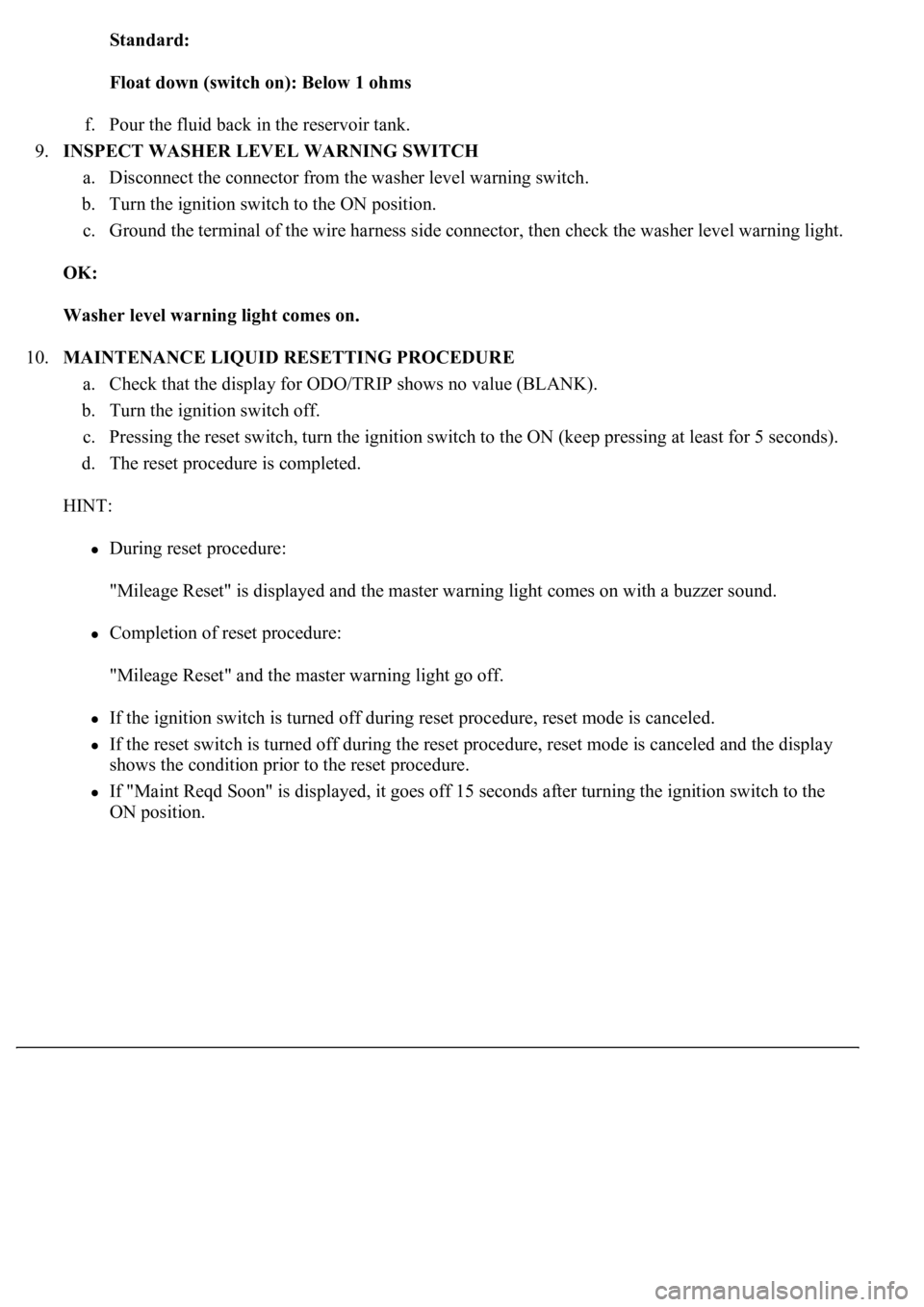Page 1839 of 4500
Fig. 85: Identifying D6 And R4 Connector Terminals
Courtesy of TOYOTA MOTOR SALES, U.S.A., INC.
6.CHECK HARNESS AND CONNECTOR (LIGHT CONTROL RHEOSTAT - DRIVER SIDE
JUNCTION BLOCK) (SEE HOW TO PROCEED WITH TROUBLESHOOTING
)
a. Disconnect the D6 and R4 connectors.
b. Measure the resistance according to the value (s) in the table below.
Standard
D6 AND R4 CONNECTORS RESISTANCE SPECIFICATIONS
Tester ConnectionConditionSpecified Condition
D6-20 - R4-3AlwaysBelow 1 ohms
D6-22 - R4-2AlwaysBelow 1 ohms
D6-21 - R4-1AlwaysBelow 1 ohms
D6-1 - R4-4AlwaysBelow 1 ohms
Page 1846 of 4500
Fig. 90: Identifying Fuel Sender Gauge Connector Terminals
Courtesy of TOYOTA MOTOR SALES, U.S.A., INC.
OK:
Needle position is on (FULL).
5.INSPECT FUEL LEVEL WARNING
a. Disconnect the connector from the sender gauge.
b. Turn the ignition switch to the ON position, then check that the fuel level needle indicates EMPTY
and the fuel level warning light comes on.
OK:
Fuel level warning light comes on.
Page 1847 of 4500

6.INSPECT LOW OIL PRESSURE WARNING LIGHT
a. Disconnect the connector from the low oil pressure switch.
b. Turn the ignition switch to the ON position.
c. Ground the terminal of the wire harness side connector, then check the low oil pressure warning
light.
OK:
Low oil pressure warning light comes on.
7.INSPECT BRAKE WARNING LIGHT
a. Inspect the parking brake warning light.
1. Disconnect the connector from the parking brake switch
2. Turn the ignition switch to the ON position.
3. Ground the terminal of the wire harness side connector, then check the parking brake
warning light.
OK:
Brake warning light comes on.
b. Inspect the brake fluid level warning light.
1. Disconnect the connector from the brake fluid level warning switch.
2. Turn the ignition switch to the ON position.
3. Connect a terminal to the other terminal of the wire harness side connector, then check the
brake fluid level warning switch.
OK:
Brake warning light comes on.
8.INSPECT BRAKE FLUID LEVEL WARNING SWITCH
a. Remove the reservoir tank cap and strainer.
b. Disconnect the connector.
c. Measure the resistance between the terminals.
Standard:
Float up (switch off): 10 kohms or higher
d. Use a syphon, etc. to take fluid out of the reservoir tank.
e. Measure the resistance between the terminals.
Page 1848 of 4500

Standard:
Float down (switch on): Below 1 ohms
f. Pour the fluid back in the reservoir tank.
9.INSPECT WASHER LEVEL WARNING SWITCH
a. Disconnect the connector from the washer level warning switch.
b. Turn the ignition switch to the ON position.
c. Ground the terminal of the wire harness side connector, then check the washer level warning light.
OK:
Washer level warning light comes on.
10.MAINTENANCE LIQUID RESETTING PROCEDURE
a. Check that the display for ODO/TRIP shows no value (BLANK).
b. Turn the ignition switch off.
c. Pressing the reset switch, turn the ignition switch to the ON (keep pressing at least for 5 seconds).
d. The reset procedure is completed.
HINT:
During reset procedure:
"Mileage Reset" is displayed and the master warning light comes on with a buzzer sound.
Completion of reset procedure:
"Mileage Reset" and the master warning light go off.
If the ignition switch is turned off during reset procedure, reset mode is canceled.
If the reset switch is turned off during the reset procedure, reset mode is canceled and the display
shows the condition prior to the reset procedure.
If "Maint Reqd Soon" is displayed, it goes off 15 seconds after turning the ignition switch to the
ON position.
Page 1883 of 4500
Fig. 31: Releasing Caulking
Courtesy of TOYOTA MOTOR SALES, U.S.A., INC.
6.REMOVE RADIATOR TANK UPPER AND TANK LOWER
a. Lightly tap the bracket of the radiator (or radiator hose inlet or outlet) with a plastic hammer and
remove the tank.
b. Remove the O-ring.
Page 1887 of 4500
Fig. 35: Inspecting Lock Plate For Damage
Courtesy of TOYOTA MOTOR SALES, U.S.A., INC.
10.INSTALL RADIATOR TANK UPPER AND TANK LOWER
a. Check that there are no foreign objects in the lock plate groove, and install a new O-ring. Make
sure the O-ring is not twisted.
HINT:
When cleanin
g the lock plate groove, lightly rub it with sandpaper without scratching it.
Page 1890 of 4500
Fig. 38: Installing Punch Assembly To Overhaul Handle
Courtesy of TOYOTA MOTOR SALES, U.S.A., INC.
12.CAULK LOCK PLATE
a. Lightly press SST against the lock plate in the order shown in the illustration. After repeating this a
few times, fully caulk the lock plate by gripping the handle until stopped by the stopper plate.
SST 09230-01010
Page 1900 of 4500

SYSTEM NAME AND PAGE REFERENCE
1.Pay attention to the following points when inspecting the cruise control system.
a. Push the cruise control main switch ON-OFF button off when not using the cruise control.
b. Be careful of vehicle speed increase when driving downhill with the cruise control on.
c. RESUME/ACCEL operation, after canceling the cruise control, works as RESUME, and works as
ACCEL while the cruise control system is in operation.
d. Push the cruise control main switch ON-OFF button off and reset the cruise control if the CRUISE
main indicator light blinks while the cruise control system is in operation. When the cruise control
cannot be set by this procedure or cancelled immediately after setting, there may be a malfunction
in the system.
e. Do not use the cruise control system where the road conditions are as follows:
Heavy traffic
Steep downhill
Sharp turns
Icy or snowy roads
Slippery roads
System NameSee Procedure
Front Power Seat Control SystemINITIALIZATION